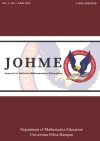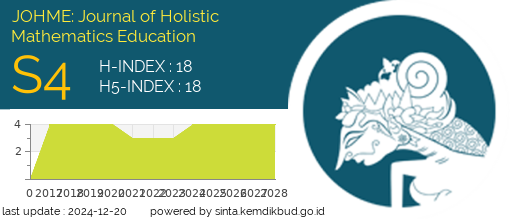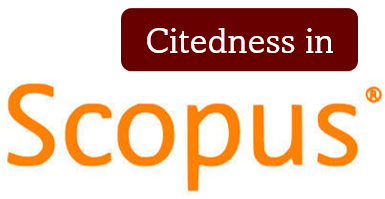INVESTIGATING SOCIAL SCIENCE STUDENTS’ UNDERSTANDING OF LIMITS THROUGH THE LENS OF THE PROCEPT THEORY
DOI:
https://doi.org/10.19166/johme.v7i1.5900Keywords:
procedure, process, concept, procept, limitsAbstract
The idea of limit is central to both differential and integral calculus. It is also applicable in other disciplines such as physics, engineering, economics, etc. Because of this, conducting a study to further improve teachers’ knowledge about how social science students (whose major is economics) understand limits is of utmost importance. The reported study sought to find out how students understand the idea of limit with regard to the use of its symbolism. Sixty first year university students in the social sciences acted as the sample of the study. An adapted procept theory was used to analyse data obtained from these students through their solution to tasks on limit and explanations on their thinking and solution processes. Qualitative analysis of data indicated that some students understood the limit symbolism to be a procept while others did not. When solving the mathematical tasks, students’ difficulties emanated from: (i) their inability to coordinate the two processes, and , or and (ii) the proper use of the limit operator, and (iii) inability to realise that the simplification has led to the same response as they could not see the relationship between the results. This resulted in misalignment between their reasoning and their choice of answers where justification was required. The results also show that limits at infinity were more problematic than those of the form as where a is a constant. Students’ choice of method used depended mostly on how much efficient the method was in terms of saving time and not really on promoting understanding. The lesson learnt from the study is that when using the adjusted procept theory, the yes or no answers do not qualify to be used in concluding the level of thinking at which students are at. It is recommended that students be asked to show their working and also explain their answers so that the type of understanding that leads to their choices come to foreReferences
Cornu, B. (1991). Limits. In D. O. Tall (Ed.), Advanced Mathematical Thinking (pp. 153 -166). Dordrecht, NL: Kluwer Academic Publishers.
Cottrill, J., Dubinsky, E., Nicholas, D., Schwingendorf, K., Thomas, K., & Vidakovic, D. (1996). Understanding the limit concept: Beginning with a coordinated process scheme. Journal of Mathematical Behavior, 15(2), 167-192. https://doi.org/10.1016/S0732-3123(96)90015-2
Denbel, D. G. (2014). Students’ misconceptions of the limit concept in a first calculus course. Journal of Education and Practice, 5(34), 24-40. Retrieved from https://core.ac.uk/download/pdf/234636567.pdf
Essien, A. A. (2021). Rethinking exemplification in mathematics teacher education multilingual classrooms. Retrieved from https://zenodo.org/record/5457116#.ZDZmmHZBzIU
Güçler, B. (2014). The role of symbols in mathematical communication: The case of the limit notation. Research in Mathematics Education, 16(3), 251-268. https://doi.org/10.1080/14794802.2014.919872
Gray E., & Tall, D. (1992). Success and failure in mathematics: Procept and procedure - A primary perspective. Retrieved from https://citeseerx.ist.psu.edu/document?repid=rep1&type=pdf&doi=f964d3be8ef76ebcff452d5e75984b662c0c66c7
Gray E., & Tall, D. (1994). Duality, ambiguity, and flexibility: A proceptual view of simple arithmetic. The Journal for Research in Mathematics Education, 26(2), 115-141. Retrieved from https://www.jstor.org/stable/749505
Gray, E., & Tall, D. (2001). Relationships between embodied objects and symbolic procepts: An explanatory theory of success and failure in mathematics. Proceedings of PME25, Utrecht, 65-72. Retrieved from http://homepages.warwick.ac.uk/staff/David.Tall/pdfs/dot2001i-pme25-gray-tall.pdf
Jones, S. R. (2015) Calculus limits involving infinity: The role of students’ informal dynamic reasoning. International Journal of Mathematical Education in Science and Technology, 46(1), 105-126. https://doi.org/10.1080/0020739X.2014.941427
Maharaj, A. (2010). An APOS analysis of students’ understanding of the concept of a limit of a function. Pythagoras: Journal of the Association for Mathematics Education of South Africa, 71, 41-52. Retrieved from https://pythagoras.org.za/index.php/pythagoras/article/view/6/6
Mellor, K., Clark, R., & Essien, A. A. (2018). Affordances for learning linear functions: A comparative study of two textbooks from South Africa and Germany. Pythagoras: Journal of the Association for Mathematics Education of South Africa, 39(1). https://doi.org/10.4102/pythagoras.v39i1.378
Monaghan, J. (1991). Problems with language of limits. For the Learning of Mathematics, 11(3), 20 - 24. Retrieved from https://www.jstor.org/stable/40248029
Moru, E. K. (2009). Epistemological obstacles in coming to understand the limit of a function at undergraduate level: A case from the National University of Lesotho. International Journal of Science and Mathematics Education, 7, 431-454. http://dx.doi.org/10.1007/s10763-008-9143-x
Sfard, A. (1991). On the dual nature of mathematical conceptions: Reflections on processes and objects as different sides of the same coin. Educational Studies in Mathematics, 22(1), 1-36. https://doi.org/10.1007/bf00302715
Starman, A. B. (2013). The case study as a type of qualitative research. Journal of Contemporary Educational Studies, 1, 28-43. Retrieved from https://www.sodobna-pedagogika.net/en/articles/01-2013_the-case-study-as-a-type-of-qualitative-research/
Skemp, R. A. (1971). The psychology of learning mathematics. Harmondsworth, UK: Penguin Books.
Skemp, R. A. (1976). Relational understanding and instrumental understanding.
Mathematics Teaching, 77, 20-26. Retrieved from http://www.davidtall.com/skemp/pdfs/instrumental-relational.pdf
Taback, S. (1975). The child’s concept of limit. In M.F. Rosskopf (Ed.), Children’s mathematical concepts (pp. 111 - 144). New York, NY: Teachers College Press.
Tall, D.O. (n.d.). The theory of PROCEPTs: Flexible use of symbols as both PROcess and conCEPT in arithmetic, algebra, calculus. Retrieved from http://www.davidtall.com/papers/3.procepts.pdf
Tall, D. O., & Thomas, M. O. J. (1991). Encouraging versatile thinking in algebra using the computer. Educational Studies in Mathematics, 22(2), 125-147. https://doi.org/10.1007/BF00555720
Tall, D. O. (1992). Mathematical processes and symbols in the mind. Retrieved from https://citeseerx.ist.psu.edu/document?repid=rep1&type=pdf&doi=c36bd769cf707ab940732b63571fd944585edb3e
Tall, D. O., Gray, E., Ali, M. B., Crowley, L., DeMarois, P., McGowen, M., Pitta. D., Pinto. M., Thomas, M., & Yusof, Y. (2001). Symbols and the bifurcation between procedural and conceptual thinking. Canadian Journal of Science, Mathematics and Technology Education, 1, 80-104. https://doi.org/10.1080/14926150109556452
Thomas, M. O. J., & Hong, Y. Y. (2001). Representations as conceptual tools: Process and structural perspectives. Retrieved from https://www.math.auckland.ac.nz/~thomas/index/staff/mt/My%20PDFs%20for%20web%20site/PME01YY.pdf
Viirman, O., Vivier, L., & Monaghan, J. (2022). The limit notion at three educational levels in three countries. International Journal of Research in Undergraduate Mathematics Education, 8(2), 222-244. https://doi.org/10.1007/s40753-022-00181-0
Williams, S. R. (1991). Models of limit held by college calculus students. Journal for Research in Mathematics Education, 22(3), 219 -236. https://doi.org/10.5951/jresematheduc.22.3.0219Downloads
Additional Files
Published
How to Cite
Issue
Section
License
Authors who publish with this journal agree to the following terms:
1) Authors retain copyright and grant the journal right of first publication with the work simultaneously licensed under a Creative Commons Attribution License (CC-BY-SA 4.0) that allows others to share the work with an acknowledgement of the work's authorship and initial publication in this journal.
2) Authors are able to enter into separate, additional contractual arrangements for the non-exclusive distribution of the journal's published version of the work (e.g., post it to an institutional repository or publish it in a book), with an acknowledgement of its initial publication in this journal.
3) Authors are permitted and encouraged to post their work online (e.g., in institutional repositories or on their website). The final published PDF should be used and bibliographic details that credit the publication in this journal should be included.”










